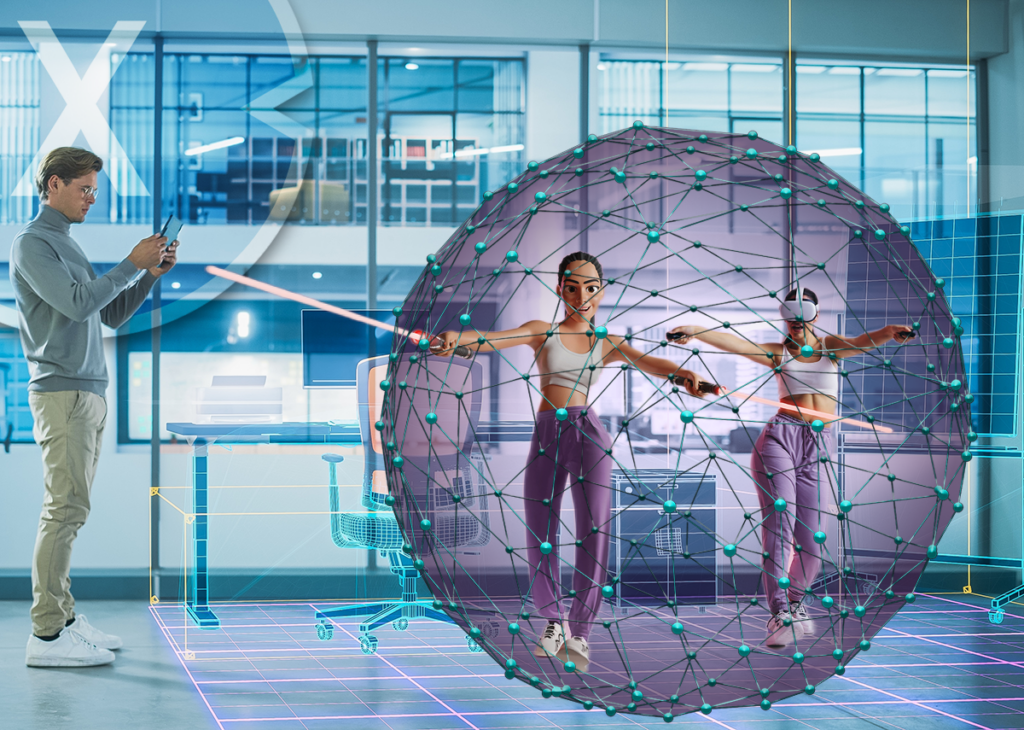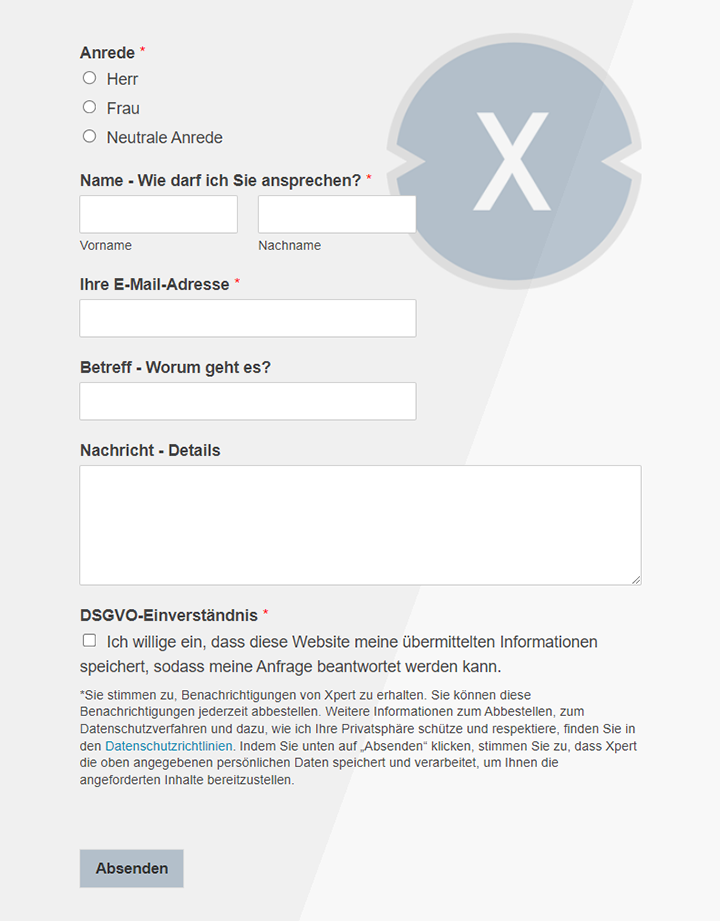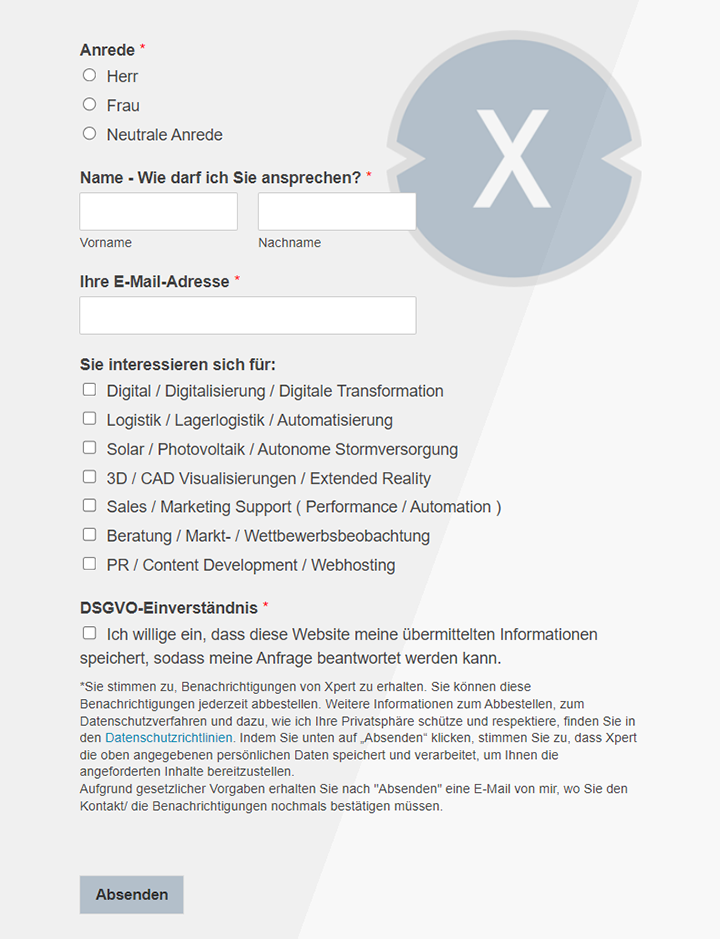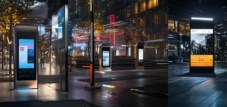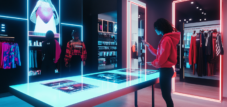Intelligent operating system – Is the Android XR operating system the future as a smart OS for interactive screens in the retail and consumer sectors?
Xpert pre-release
Language selection 📢
Published on: December 20, 2024 / Update from: December 20, 2024 - Author: Konrad Wolfenstein

Intelligent operating system – Is the Android XR operating system the future as a smart OS for interactive screens in the retail and consumer sectors? – Image: Xpert.Digital
Intelligent operating system of the future? Android XR and its groundbreaking possibilities
The Android XR operating system, developed by Google in collaboration with Samsung, marks a significant advance in the integration of extended reality (XR) technologies. It includes virtual reality (VR), augmented reality (AR) and mixed reality (MR) and has the potential to fundamentally change the way we use interactive technologies. With its advanced features and versatile applications, it proves to be an intelligent operating system (Smart OS) that can set new standards in both the retail and consumer sectors.
We think one step further, because cross-device systems and software that work on all devices (smartphones, touchscreens and XR glasses) in the “Smard 3D” format is already there-just not yet as a smart OS operating system:
While Android XR is primarily designed for XR devices, there is no specific information in the available sources that it can be directly optimized or deployed for touchscreens. Control is primarily through gestures and voice, targeting the immersive nature of VR and AR experiences.
However, Android However, this would require adjustments as Android XR's focus is on hands-free interactions.
Suitable for:
- Opening up new markets: Interactive customer experiences with Android XR, augmented reality and intelligent displays
- Extended Reality at the Intersolar trade fair: How Bürkle is revolutionizing digital 3D product presentation with SmartVu
Key features of Android XR
1. Unified XR ecosystem
Android XR was created to consolidate the fragmented XR market through a unified platform. The open ecosystem enables seamless compatibility between headsets, AR glasses and smart glasses. This reduces market fragmentation and offers developers and manufacturers a flexible basis. This integration greatly facilitates the development and use of XR applications and provides a foundation for long-term innovation.
Suitable for:
2. AI integration by Gemini
The Gemini AI Assistant is a core part of Android XR and offers a wide range of intelligent features. Natural interactions via voice commands, gesture recognition and eye tracking are among the prominent features. Using 3D mapping, real-time translations and contextual support, Gemini creates an intuitive user experience. These features not only enrich the interaction but also expand the possible uses in various areas such as entertainment, education and commerce.
3. Compatibility with existing apps
A key advantage of Android XR is its compatibility with millions of existing Android apps from the Google Play Store. This enables immediate usability for productivity, entertainment and retail applications. Developers can also create immersive XR-specific apps without having to learn new programming languages or tools. This combination of familiarity and innovation makes Android XR an attractive platform for developers and consumers alike.
4. Multimodal interactions
Users can interact with XR devices in a variety of ways, including voice commands, hand gestures, gaze control, or traditional controllers. This flexibility ensures that different user preferences and application scenarios are covered. The multimodal interaction makes it possible to use the technology efficiently in both private and professional environments.
5. Optimized hardware integration
The platform has been specifically optimized for advanced XR hardware. These include high-resolution displays, surround sound and low latency. An example of this is Samsung's Project Moohan headset, which offers mixed reality modes and high-quality visuals. This streamlined integration ensures an immersive and smooth user experience.
Retail and consumer applications
Android XR offers numerous uses in retail and consumer markets, ranging from interactive shopping experiences to immersive advertising.
Interactive shopping experiences
Retailers can use AR-enabled smart displays with Android XR to create innovative shopping experiences. Virtual trying on clothes or shoes is an example of how customers can visualize products through gesture-based interactions. These technologies not only increase customer satisfaction, but also offer new possibilities for product presentation.
Increased customer loyalty
Customers can be specifically addressed through immersive product presentations and virtual tours of shop layouts. AI assistant Gemini personalizes the shopping experience through recommendations based on real-time customer behavior. These personalized approaches increase loyalty and encourage longer time in store.
Training and continuing education
VR headsets with Android XR can be used for retail training or employee development. For example, realistic simulations for customer service or warehouse management can be created. Consumers also benefit from interactive 3D instructions that help with product assembly or repairs.
Immersive advertising
Android XR enables immersive multimedia experiences such as 3D advertising or virtual pop-up stores. These combine digital content with real environments, creating an innovative advertising platform that stands out clearly from traditional formats.
Advantages over competing platforms
Open platform
In contrast to closed systems like Apple's visionOS, Android XR offers an open ecosystem. This flexibility promotes innovation, reduces costs for consumers and offers developers more freedom.
AI-driven features
Gemini AI integration elevates Android XR with advanced features such as real-time translation and environmental awareness. These features are more comprehensive than those offered by many competitors and make the platform particularly attractive.
Cross-device compatibility
Android XR leverages the strengths of the broad Android ecosystem. This means devices are not only compatible with existing apps, but also offer new immersive experiences. This compatibility makes integration into existing systems easier and expands the possible uses.
Challenges and market outlook
Despite its enormous potential, Android XR faces some challenges:
Consumer acceptance
The market for AR/VR devices remains niche compared to smartphones. Although forecasts predict growth in global shipments of AR/VR headsets, widespread consumer adoption is still limited.
Hardware development
Although Samsung's Project Moohan headset is expected in 2025, developing affordable and fashionable smart glasses remains a challenge. These devices are crucial to making XR technologies accessible to a broader audience.
However, as AI technologies continue to develop and compelling applications are created, Android XR could see wider adoption in both the consumer and enterprise markets.
Potential for interactive displays and immersive technologies
Android XR combines advanced technology with an open platform and versatile applications. It has the potential to revolutionize interactive displays and immersive technologies in retail and consumer sectors. Despite existing challenges such as consumer adoption and hardware availability, Android XR positions itself as a transformative force in the XR landscape thanks to its innovative approach. The combination of AI-driven features, cross-device compatibility, and an open ecosystem makes it a promising candidate for the future of extended reality.
Suitable for:
🗒️ Xpert.Digital: A pioneer in the field of extended and augmented reality
The Android XR operating system: A new era of extended reality
The evolution of extended reality technologies
The Android XR operating system, developed by Google in close collaboration with Samsung, marks a significant step in the evolution of extended reality (XR) technologies. These include virtual reality (VR), augmented reality (AR) and mixed reality (MR) and are increasingly merging into a unified field of digital experiences. Android
Android XR: More than just an upgrade
“Android XR is more than just an upgrade of existing operating systems”-rather it opens up a completely new chapter in which devices such as headsets, AR glasses and interactive displays communicate with each other in order to form a consistent and versatile ecosystem. The core of this development lies in a simple, open structure that allows developers to freely implement their creative ideas and to offer the end user a uniform use of use. Instead of thinking in islands in islands, in which VR, AR and MR each used their own, often incompatible platforms and devices, Android XR creates a foundation on which all technologies grow together seamlessly.
Suitable for:
Gemini: The AI assistant as a bridge between people and technology
A heart of this platform is the integration of a AI assistant called Gemini. “Gemini acts as a bridge between man and machine” and allows natural interactions using voice commands, gesture control or eye tracking. In contrast to conventional operating systems, the user experience becomes as intuitive as a conversation among people. The AI assistant not only analyzes the environment, but also the context in which the user is located. Whether you virtually try on a product in the store, translate a foreign language in real time or want to receive detailed information about an issued article: Gemini understands the wishes of the user and reacts in real time. This creates an ecosystem in which technology and everyday life merge without having to worry about complex menu guides or cumbersome settings.
Compatibility with existing Android apps
Another central advantage of Android XR is the seamless compatibility with millions of existing Android apps. While new applications specially designed for XR are created step by step, the user can use a wide range of well -known offers from the start. Productivity tools, entertainment offers or shopping apps are expanded by XR functions and are therefore attracted to attractiveness. "The already familiar applications are placed in an expanded context"-for example, a conventional purchasing app can be supplemented by AR functions in order to present products in a three-dimensional view and to provide virtual try-on. Or a learning tool becomes immersive experience in which specialist content can be experienced.
Multimodal interaction: Flexibility through various input options
Various input options are available to the user for interaction with Android XR. Voice commands are just a component in the interaction of gesture recognition, view control and the use of traditional controllers. This multimodality creates flexibility and facilitates access by adapting to the respective situation and preference of the user. "The future of the XR interaction will be free of rigid operating concepts"-whether you control a virtual menu navigation through hand gestures like a conductor in the room or make a selection by eye focus is left to individual comfort.
Hardware integration: An interplay of software and innovative technology
A key aspect is also optimized hardware integration. Android XR is not just a software upgrade; It is close with high -resolution displays, advanced indoor sound, haptic feedback and extremely low latency. Samsung's planned project moohan headset should demonstrate this interaction as an example and show how mixed reality becomes a natural part of the experience. The hardware is designed to kidnap the user into virtual worlds that seem so convincing that the border between real and digital world disappears. "With Android XR, the technology becomes invisible and the focus is on the experience itself."
Potential in retail: Interactive customer experiences
The possible uses for Android XR are diverse. There is enormous potential, especially in retail. Interactive displays equipped with XR functions can be used in stores to take customers on a completely new journey of discovery. Virtual fittings of clothing or shoes can be implemented directly in the store experience without the customer having to physically go into a changing room. Instead, the XR display projects the selected product onto the user's body, takes its dimensions into account and enables a quick, convincing purchase decision. This way of shopping saves time, reduces returns and creates an engaging brand experience.
Suitable for:
Inspiration and interaction: new dimensions of shopping
In addition, retailers can rely on immersive product presentations and virtual tours through their shops. "Shopping becomes an inspiring interaction from a pure transaction." Customers can browse through handwashed shelves, call up products or display recommendations, while the AI assistant submits contextual proposals to them. Customer loyalty is strengthened because the shopping experience becomes more personal, lively and more entertaining. Instead of just seeing information on a flat screen, the customer enters an extended world in which products and services can be experienced in the three -dimensional space.
Innovation for training and further education
New horizons are also opening up in the area of employee training and further education. Sales teams could use VR headsets to be trained in practical simulations: for example, in scenarios in which they train customer service, product presentation or warehousing. Thanks to the immersive possibilities of Android XR, learning content is not only conveyed, but experienced. This increases the understanding, motivation and sustainability of what has been learned. Interactive 3D instructions also offer added value for the end user: How do I assemble a newly purchased piece of furniture without having to decipher complicated instructions on paper? An XR system guides you through the construction step by step, projects virtual clues directly onto the real object and helps avoid errors and frustration.
Android XR: Advertising as an immersive experience
Thanks to Android XR, advertising becomes an immersive experience that goes beyond static pictures and videos. Interactive 3D advertisements or virtual pop-up stores enable new marketing strategies in which customers explore products and brand worlds before making a purchase decision. This type of advertising combines digital content with the real environment and creates an experience that remains in the memory. "Advertising is no longer only considered, but actively experienced."
Open platform structure: Competitive advantage of Android XR
Compared to competing platforms such as Apple's visionos or METAS quest ecosystem, Android XR scores with an open structure, versatile compatibility and AI-controlled functions. While some competitors are relying on a closed system that directs manufacturers and developers in close lanes, Android XR promotes an open innovation culture. This openness leads to cheaper devices, a larger variety of applications and an overall faster market maturity of new ideas. Gemini, the AI assistant, offers a decisive lead: real-time translations, spatial environmental analysis and context-related recommendations are functions that enrich everyday life without the user having to deal with technical details. "Technology understands people, not people."
Challenges on the way to widespread acceptance
Of course there are also challenges. The market for AR/VR devices is still niche compared to traditional smartphones. The breakthrough depends on factors such as design, price and concrete added value. Although the availability of powerful headsets has been announced, the development of fashionable and everyday smart glasses that appeal not only to technology enthusiasts but also to the mainstream remains a task for the coming years. Related to this is the question of user acceptance: Are consumers willing to buy new hardware and change their viewing habits to immerse themselves in the world of XR experiences?
Technological progress and growing application scenarios
But technical progress is advancing, and with it the application scenarios are also growing. As AI technologies become more refined, the content and features Android XR offers will become more compelling. As soon as consumers clearly see the added value - be it in more convenient shopping, improved customer service or exciting leisure activities - the likelihood of broad market acceptance increases. Additionally, as a comprehensive ecosystem of hardware options, apps and services becomes established, Android XR will become a foundational infrastructure for our digital future.
"The conclusion is clear: Android XR redefines the interface between man, machine and the surrounding area." By integrating XR technologies into a familiar Android ecosystem, it opens up new opportunities for retail, the consumer market and beyond. The success will depend on how well it will be possible to implement the promised advantages into concrete, noticeable added value. It is more than just technical feasibility - it is about the willingness of the users to accept and actively use this new dimension of digitization.
Potential in education, medicine and industry
In the future, Android XR could also revolutionize areas such as education, medicine, architecture or industrial production. Virtual classrooms are conceivable in which learners “visit” interactively historical events or explore anatomical models in virtual form. Architects and designers could present their designs with customers three -dimensional and in a real context without ever having to build a physical model. In industry, employees in turn can virtually assemble complex machines through XR applications and thus recognize sources of error in advance.
Android XR as the technological basis of the future
All of these examples show that Android XR is more than a niche product. It is a technological basis that can be flexibly transferred to a wide variety of use cases. With the further development of Gemini, improved hardware, increasing app variety and growing user interest, Android XR could become as commonplace in just a few years as a smartphone is today. The key to success lies in making the transition from purely technical feasibility to a meaningful, intuitive and pleasant user experience.
The transformative power of Android XR
The signs are good that Android XR will be a transformative force in the XR landscape. The combination of AI-driven features, open platform philosophy, broad app compatibility and immersive experiences lays the foundation for a future in which digital and real worlds mesh harmoniously. Once the necessary technological and cultural conditions are met, Android XR will be an integral part of our everyday lives, fundamentally changing the way we perceive commerce, education, entertainment and work.
“Android XR combines the fascination of the virtual with the usefulness of the real” - and that is exactly his enormous potential. It not only offers improvements for existing industries, but also opens up completely new ways to consume information, gain experience and interact with our environment. The next few years will show how far this path leads and what innovations are still in the pipeline. But it is already clear: Android XR is much more than a technical gimmick - it is a milestone on the way to an extended, more intelligent and more fascinating digital future.
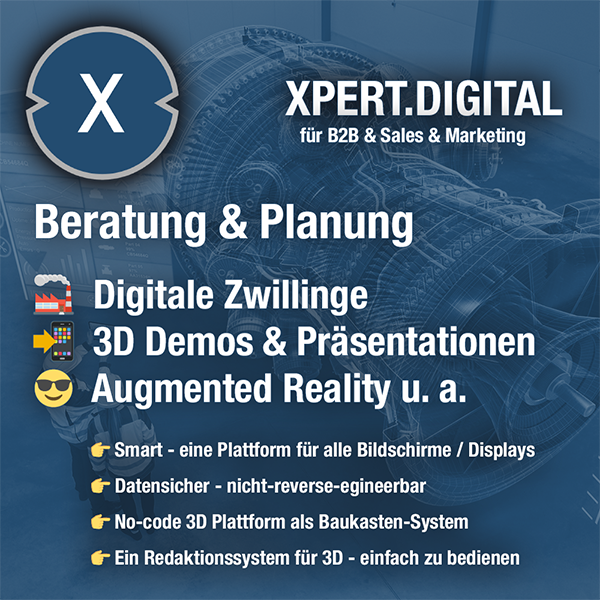
We are there for you - advice - planning - implementation - project management
Xpert.Digital - Pioneer Business Development
Smart Glasses & KI - XR/AR/VR/MR industry expert
Consumer metaverse or meta -verse in general
If you have any questions, further information and advice, please feel free to contact me at any time.
I would be happy to serve as your personal advisor.
You can contact me by filling out the contact form below or simply call me on +49 89 89 674 804 (Munich) .
I'm looking forward to our joint project.
Xpert.Digital - Konrad Wolfenstein
Xpert.Digital is a hub for industry with a focus on digitalization, mechanical engineering, logistics/intralogistics and photovoltaics.
With our 360° business development solution, we support well-known companies from new business to after sales.
Market intelligence, smarketing, marketing automation, content development, PR, mail campaigns, personalized social media and lead nurturing are part of our digital tools.
You can find out more at: www.xpert.digital - www.xpert.solar - www.xpert.plus



